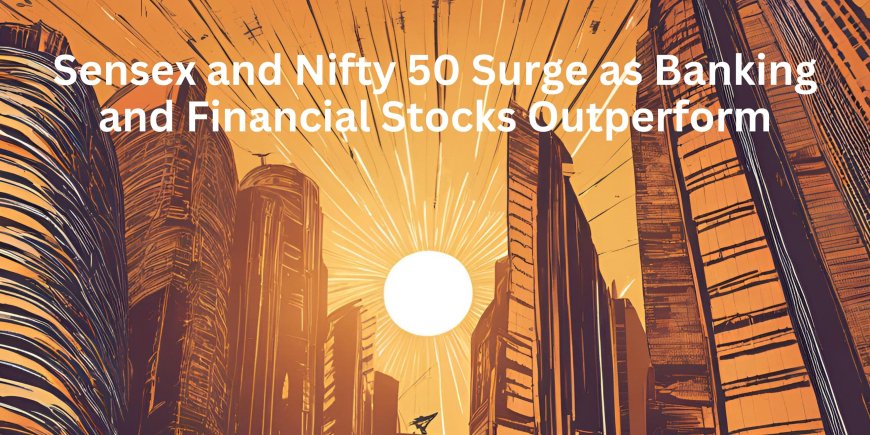Sensex and Nifty 50 Surge as Banking and Financial Stocks Outperform
The Sensex closed at 63,416.03, up by 446.03 points, while the Nifty 50 ended at 18,817.40, higher by 126.20 points. Banking and financial stocks surged, driven by positive merger updates involving HDFC Bank and strong corporate earnings.

The Indian stock markets have shown impressive resilience and growth, with the Sensex and Nifty 50 indices closing significantly higher. On the recent trading day, the Sensex closed at 63,416.03, up by 446.03 points, while the Nifty 50 ended at 18,817.40, higher by 126.20 points. This performance has been largely driven by strong gains in the banking and financial sectors, influenced by recent merger updates involving HDFC Bank. The following analysis delves into the key factors contributing to this market movement, the performance of various sectors, and the implications for investors.
Performance Overview
The robust performance of the Sensex and Nifty 50 can be attributed to several factors, including positive domestic economic indicators, strong corporate earnings, and specific developments within the banking and financial sectors.
Key Highlights:
- Sensex Surge: The Sensex, India's benchmark equity index, climbed by 446.03 points to close at 63,416.03. This rise represents a 0.71% increase, reflecting broad-based buying interest across various sectors.
- Nifty 50 Gains: The Nifty 50, another key equity index, rose by 126.20 points to settle at 18,817.40. This increase of 0.68% highlights the overall positive sentiment among investors.
Banking and Financial Sector Performance
The banking and financial sectors were the standout performers in the recent trading session. Several factors contributed to the strong performance of these sectors:
Merger Updates Involving HDFC Bank:
- HDFC Bank's Merger with HDFC Ltd.: The merger between HDFC Bank and HDFC Ltd. has been a significant development, driving positive sentiment in the banking sector. The merger is expected to create a financial powerhouse with a strong balance sheet and diversified portfolio, enhancing the competitive positioning of the merged entity.
- Market Reaction: Investors have reacted positively to the merger news, anticipating synergies and efficiencies that could result from the consolidation. This optimism has led to increased buying activity in HDFC Bank's stock, which in turn has influenced the broader banking sector.
Strong Corporate Earnings:
- Earnings Reports: Several banks and financial institutions have reported robust earnings, reflecting improved asset quality and higher credit growth. Strong earnings from major players such as State Bank of India (SBI), ICICI Bank, and Kotak Mahindra Bank have bolstered investor confidence in the sector.
- Credit Growth: The banking sector has seen a steady increase in credit growth, driven by rising demand for loans from both retail and corporate segments. This trend is indicative of a recovering economy and bodes well for the profitability of banks.
Regulatory Support:
- Regulatory Measures: The Reserve Bank of India (RBI) has implemented various measures to support the banking sector, including liquidity infusion and regulatory forbearance. These measures have provided a favorable operating environment for banks, helping them navigate challenges and maintain stability.
Sectoral Performance
Beyond the banking and financial sectors, other sectors also contributed to the positive market performance:
Information Technology (IT):
- Tech Stocks: The IT sector continued to perform well, driven by strong demand for digital transformation services and robust order books. Companies like Infosys, TCS, and Wipro reported healthy earnings, reinforcing the sector's growth prospects.
Healthcare:
- Pharma Gains: The healthcare sector, particularly pharmaceutical stocks, saw gains as companies reported strong earnings and favorable developments in drug approvals and exports. Major players like Dr. Reddy's Laboratories and Sun Pharmaceutical Industries were among the top performers.
Consumer Goods:
- FMCG Stocks: The fast-moving consumer goods (FMCG) sector experienced positive momentum, supported by strong consumer demand and favorable monsoon forecasts. Companies such as Hindustan Unilever and ITC posted gains, reflecting robust consumption trends.
Automobile:
- Auto Sector: The automobile sector also contributed to the market's rise, with major automakers reporting higher sales figures and positive outlooks. Stocks like Maruti Suzuki and Tata Motors benefited from increasing vehicle demand and new model launches.
Economic Indicators and Market Sentiment
The overall market sentiment was bolstered by positive economic indicators and supportive policy measures:
Economic Growth:
- GDP Growth: India's GDP growth has shown signs of recovery, with improved industrial production and robust services sector performance. The government's focus on infrastructure development and reforms has further supported economic growth prospects.
- Consumer Confidence: Rising consumer confidence, as evidenced by increased spending and higher retail sales, has also contributed to the positive market sentiment.
Inflation and Interest Rates:
- Inflation Trends: While inflation remains a concern, recent data has shown some moderation in price pressures. The RBI's efforts to manage inflation through monetary policy measures have been closely watched by investors.
- Interest Rates: The RBI's decision to maintain accommodative interest rates has provided a favorable environment for businesses and consumers, supporting economic activity and market growth.
Strategic Implications for Investors
Given the current market dynamics, investors are adopting various strategies to capitalize on opportunities and manage risks:
Diversification:
- Sector Rotation: Investors are considering sector rotation strategies to capitalize on sectors expected to benefit from economic recovery, such as banking, infrastructure, and consumer goods.
- Balanced Portfolios: Maintaining a balanced portfolio with exposure to high-growth sectors like IT and healthcare, alongside stable sectors like consumer goods, can help mitigate risks.
Risk Management:
- Hedging Strategies: To protect against market volatility, investors are employing hedging strategies such as options and futures. These instruments can help manage downside risks while maintaining exposure to potential upside.
- Quality Stocks: Focusing on high-quality stocks with strong fundamentals, stable earnings, and solid growth prospects can provide a buffer against market fluctuations.
Monitoring Economic Indicators:
- Inflation Data: Keeping a close eye on inflation data and central bank actions is crucial for assessing potential impacts on interest rates and market conditions.
- Growth Indicators: Monitoring GDP growth, industrial production, and consumer spending trends can provide insights into the overall economic health and inform investment decisions.
Conclusion
The Indian stock markets have demonstrated strong performance, with the Sensex and Nifty 50 indices closing significantly higher. The banking and financial sectors were key drivers of this growth, influenced by positive merger updates involving HDFC Bank, strong corporate earnings, and supportive regulatory measures. Other sectors, including IT, healthcare, consumer goods, and automobiles, also contributed to the positive market momentum.
Positive economic indicators, such as GDP growth and consumer confidence, have further bolstered market sentiment. However, investors remain cautious about inflation trends and interest rate decisions. Strategic diversification, risk management, and close monitoring of economic indicators are essential for navigating the dynamic market environment and capitalizing on opportunities.
As the Indian economy continues to recover and evolve, staying informed and adaptable will be key to achieving investment success in the months ahead.

 LD Web Desk
LD Web Desk 